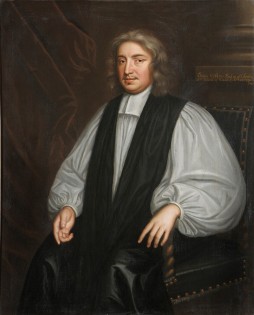The seventeenth century saw unprecedented changes in our understanding of the universe, spurred on by the invention of the telescope and the opportunity to study stars and planets in detail for the first time.
Figures like Galileo are famous for their work not just in astronomy but in scientific experiments of many kinds that challenged established ideas and helped lead to the final demise of an Earth-centred view of the cosmos.
Now historian Prof. Allan Chapman of Wadham College, University of Oxford, has investigated a less well-known pioneer, John Wilkins, who was born 400 years ago this month. His achievements include a plan for ‘mechanical’ space travel, the popularisation of astronomy, managing to negotiate the politics and privations of the English Civil War and helping to found the Royal Society. Prof. Chapman will describe Wilkins’ life in a presentation at the Royal Astronomical Society on Friday 10 January.
John Wilkins was born in Canons Ashby, Northamptonshire, on 1 January 1614. A graduate of Magdalen Hall, Oxford, he was ordained as a priest in the Church of England, before travelling widely in the UK and to Germany to meet contemporary scholars. In 1638 he published ‘The Discovery of a New World’ and then in 1640 ‘A Discourse Concerning a New Planet’. The frontispiece of the later book shows his affinity for the Copernican model of the Solar system, with the Polish astronomer and Galileo both prominent. Just as significantly, the illustration shows the stars extending to infinity, rather than being in a then conventional ‘fixed sphere’ just beyond Saturn.
With the two works, Wilkins used clear, concise English to popularise a new understanding of the universe, arguing passionately against the theories of Aristotle that dated back 2000 years. He understood how these ancient ideas (for example that it was in the nature of heavy objects to fall, whereas light materials like smoke would rise) had been fundamentally undermined by scientific discoveries. The model of the cosmos had completely changed over the course of the century since Copernicus.

Chapman argues that science was advancing more dramatically in Wilkins’s day than today, in that although the pace of change was slower, the philosophical shift was stark and the world of the mid-seventeenth century was unrecognisable to someone born just fifty years earlier.
He sees John Wilkins as one of the first people to understand the power of mass communication for astronomy and as an intellectual ancestor of the late Sir Patrick Moore and Carl Sagan. “Wilkins was a pioneer of English language science communication. Anybody who could read the Bible or enjoy a Shakespeare play could relate to Wilkins’ vision of the new astronomy of Copernicus and Galileo.’
Remarkably, Wilkins also speculated on space travel in his 1640 work. He considered the problems of travel to the Moon, including overcoming the gravitational pull of the Earth, the coldness of space and what the ‘sky voyagers’ would eat during a journey that he thought would take about 180 days.
In 1648, after becoming Master of Wadham College in Oxford, Wilkins expanded these ideas in ‘Mathematical Magick’, a book which describes machines and how systems of gears, pulleys and springs make at first sight insurmountable tasks possible. There he discusses a ‘flying chariot’, a ship like vehicle with bird’s wings, powered by springs and gears that would carry the astronauts on their six month journey. Robert Hooke’s posthumous diary suggests that he and Wilkins may even have built a model of this aircraft.
Chapman comments, “John Wilkins was the first person to discuss space travel from a scientific and technological perspective rather than as an aspect of fantasy literature. In his writing he initiates a ‘Jacobean Space Programme’, a serious proposal for travelling to other worlds”.
These achievements are remarkable in their own right and more so given the turmoil England faced at the time. 1642 saw the onset of the English Civil War, a conflict that led to the abolition of the Anglican Church, the beheading of King Charles I and the Archbishop of Canterbury and the ascendancy of Oliver Cromwell as Lord Protector. A consummate diplomat, Wilkins even managed to marry Cromwell’s sister, took on the post at Wadham after opponents of Cromwell were purged and yet made the College a centre of tolerance that hosted a club of scientists.
After the restoration of the monarchy in 1659, Wilkins was removed from his next post as Master of Trinity College, Cambridge but nonetheless went on to found and become Secretary of the Royal Society and was appointed Bishop of Chester in 1668. He died in 1671.
Prof. Chapman sees 2014, the four hundredth anniversary of Wilkins’ birth, as a good time to reflect on the life of a remarkable figure in seventeenth century science: “As Warden of Wadham College, Oxford, John Wilkins shaped the careers of two two young men who were destined to become two of the greatest scientists in British history; Sir Christopher Wren – an astronomer before he became an architect – and Dr Robert Hooke.
“His thinking was far ahead of his time. By the time of his death in 1672, new scientific discoveries had shown that the moon voyage of 1638 was impossible. And humanity would have to wait another 300 years before getting into space.”
Contributing Source : Royal Astronomical Society




